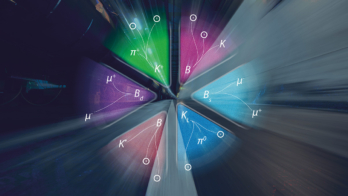Gauge Theory of Weak Decays: The Standard Model and the Expedition to New Physics Summits, by Andrzej J Buras, Cambridge University Press

Most travellers know that it is essential to have a good travel guide when setting out into unexplored territory. A book where one can learn what previous travellers discovered about these surroundings, with both global information on the language, history and traditions of the land to be explored, and practical details on how to overcome day-to-day difficulties. Andrzej Buras’s recent book, Gauge Theory of Weak Decays, is the ideal guide for both new physicists and seasoned travellers, and experimentalists and theoreticians alike, who wish to start a new expedition into the fascinating world of weak meson decays, in pursuit of new physics.
The physics of weak decays is one of the most active and interesting frontiers in particle physics, from both the theoretical and the experimental points of view. Major steps in the construction of the Standard Model (SM) have been made possible only thanks to key observations in weak decays. The most famous example is probably the suppression of flavour-changing neutral currents in kaon decays, which led Glashow, Iliopoulos and Maiani to postulate, in 1970, the existence of the charm quark, well before its direct discovery. But there are many other examples, such as the heaviness of the top quark, inferred from the large matter-to-antimatter oscillation frequency of neutral B mesons, again well before its discovery. In the post-Higgs-discovery era, weak decays are a privileged observatory in which to search for signals of physics beyond the SM. The recent “B-physics anomalies”, reported by LHCb and other experiments, could indeed be the first hint of new physics. The strategic role that weak decays play in the search for new physics is further reinforced by the absence on the horizon, at least in the near future, of a collider with a centre-of-mass energy exceeding that of the LHC, while the LHC and other facilities still have a large margin of improvement in precision measurements.

As Buras describes with clarity, signals of new physics in the weak decays of K, D, and B mesons, and other rare low-energy processes, could manifest themselves as deviations from the precise predictions of the corresponding decay rates that we are able to derive within the SM. In the absence of a reference beyond-the-SM theory, it is not clear where, and at which level of precision, these deviations could show up. But general quantum field theory arguments suggest that weak decays are particularly sensitive probes of new physics, as they can often be predicted with high accuracy within the SM.
The two necessary ingredients for a journey in the realm of weak decays are therefore precise SM predictions on the one hand, and a broad-spectrum investigation of beyond-the-SM sensitivity on the other. These are precisely the two ingredients of Buras’s book. In the first part, he guides the reader though all the steps necessary to arrive to the most up-to-date predictions for rare decays. This part of the book offers different paths to different readers: students are guided, in a very pedagogical way, from tree-level calculations to high-precision multi-loop calculations. Experienced readers can directly find up-to-date phenomenological expressions that summarise the present knowledge on virtually any process of current experimental interest. This part of the book can also be viewed as a well-thought-out summary of the history of precise SM calculations for weak decays, written by one of its most relevant protagonists.
Beyond the Standard Model
The second part of the book is devoted to physics beyond the SM. Here the style is quite different: less pedagogical and more encyclopaedic. Employing a pragmatic approach, which is well motivated to discuss low-energy processes, extensions of the SM are classified according to properties of hypothetical new heavy particles, from Z′ bosons to leptoquarks, and from charged Higgs bosons to “vector-like” fermions. This allows Buras to analyse the impact of such models on rare processes in a systematic way, with great attention paid to correlations between observables.
To my knowledge, this book is the first comprehensive monograph of this type, covering far more than just the general aspects of SM physics, as may be found in many other texts on quantum field theory. The uniqueness of this book lies in its precious details on a wide variety of interesting rare processes. It is a key reference that was previously missing, and promises to be extremely useful in the coming decades.





